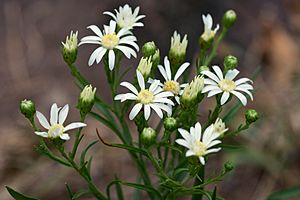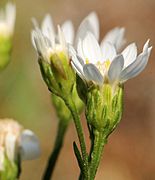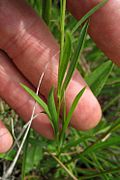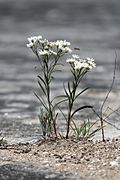Prairie goldenrod facts for kids
Quick facts for kids Prairie goldenrod |
|
|---|---|
 |
|
| Scientific classification | |
| Genus: |
Solidago
|
| Species: |
ptarmicoides
|
| Synonyms | |
|
Synonymy
Aster albus (Nutt.) Eaton 1829 not Willd. ex Spreng. 1826
Aster ptarmicoides Torr. & A. Gray Chrysopsis alba Nutt. Diplopappus albus (Nutt.) Lindl. ex Hook. Doellingeria ptarmicoides Nees Eucephalus albus (Nutt.) Nutt. Heleastrum album (Nutt.) DC. Inula alba Nutt. Oligoneuron album (Nutt.) G. L. Nesom Solidago asteroides Semple Solidago bernardii B. Boivin Unamia alba (Nutt.) Rydb. Unamia ptarmicoides (Nees) Greene |
|
The prairie goldenrod (scientific name: Solidago ptarmicoides) is a beautiful flowering plant. It is also known by other names like white flat-top goldenrod or upland white aster. This plant is a perennial, meaning it lives for more than two years. It belongs to the sunflower family.
You can find the prairie goldenrod growing naturally across North America. It lives in central and eastern Canada, from New Brunswick to Manitoba. In the United States, it grows in the Great Lakes region, the Northeast, and the Ozarks. It is also found in the northern Great Plains. Sometimes, you can spot small groups of these plants in Wyoming, Colorado, Oklahoma, and parts of the Southeast.
What Does Prairie Goldenrod Look Like?
The prairie goldenrod is special because of its flowers. Unlike many other goldenrods, its flowers are white or cream-colored. They grow in flat-topped clusters called a corymb. This is different from the long, narrow clusters (called racemes) that many other goldenrods have.
One plant can produce up to 50 small flower heads. The leaves of the prairie goldenrod are long and thin, like lines. They are often quite stiff to the touch. This plant likes to grow in dry, sandy soils. You can often find it in grassy meadows.
Is Prairie Goldenrod in Danger?
In some parts of the United States, the prairie goldenrod needs protection. It is listed as an endangered plant in several states. This means there are very few of them left, and they are at risk of disappearing forever.
The plant is endangered in Connecticut, Massachusetts, New Hampshire, North Carolina, and Tennessee. It is considered rare in Indiana, meaning it is not common there. In Ohio, it is thought to be extirpated. This means it no longer grows naturally in Ohio, even though it once did. Protecting these plants helps keep our natural world healthy.




